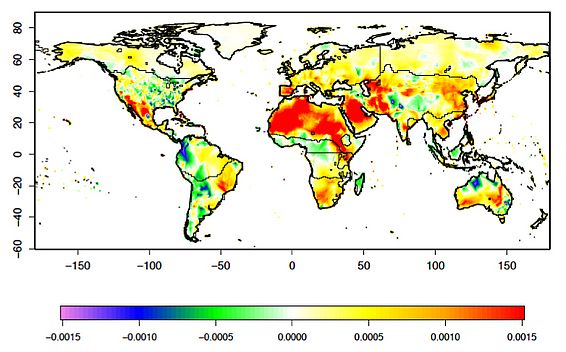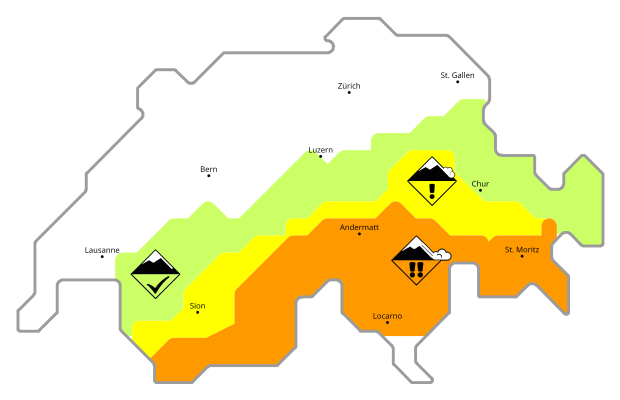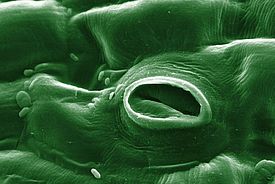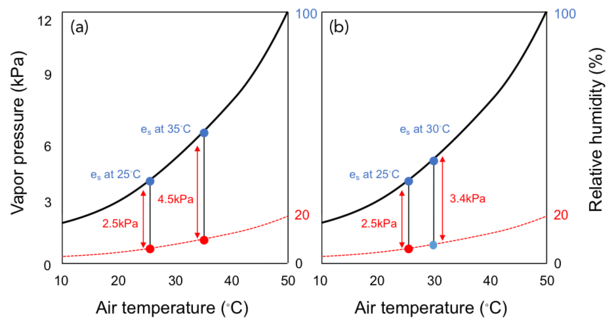VPD (Vapor Pressure Deficit) is one of the main forces governing plant transpiration. It is therefore a major component of the water cycle and indirectly of the carbon cycle. While this principle of geophysics has been known for a long time, its recent increase has been drawing the attention of plant ecophysiologists.

VPD is defined as the difference between the amount of water in the atmosphere (or "actual vapor pressure") and the amount of water the atmosphere could hold at saturation (100% humidity, or "saturation vapor pressure").
At a given temperature, the atmosphere can only hold a certain amount of water vapor. With global warming in recent decades, the upper limit on the amount of water vapour the atmosphere can hold has increased - the warmer the air, the more water vapor it can hold.
The amount of water vapor actually present in the atmosphere has not increased at the same rate, partly because evaporation from the oceans has been declining over the last 20 years, for reasons that are still unclear. The difference between these two vapor pressures, i.e. the VPD, has therefore also increased.
Why is VPD important?
Numerous studies have been conducted on plant responses to high temperatures, drought events and elevated CO2 concentrations, but the independent effects of high VPD on vegetation dynamics are still poorly understood. Yet, the increase in VPD affects the physiology of plants independently of other factors associated with climate change.
What are the consequences of high VPD?
High VPD usually causes plants to close their stomata in order to reduce water loss and avoid hydraulic malfunction (cavitation). However, this occurs at the cost of reduced carbon uptake during photosynthesis. At the same time, transpiration rate increases with high VPD up to a point after which it either remains high or starts decreasing, which can further increase plant water stress.
Elevated VPD has been suggested as having a significant role in recent and future drought-associated mortality events in all forested continents. For example, recent vegetation die-offs (widespread and fast mortality events) of conifers in southwestern USA have been more strongly correlated with VPD than with either temperature or precipitation anomalies.
In addition to its direct impact on plant physiology, high VPD accelerates evaporation from moist soils, thus creating a vicious cycle of soil drying, warming of land surfaces, and plant water stress.
All these mechanisms combine to make VPD a major determinant of global water resources and vegetation water stress.
Perspectives
Globally, VPD has increased in recent decades, a trend that is expected to continue in the future. Although its impacts on vegetation vary across biomes and plant types, and may be partially mitigated in the long term by increasing CO2 concentrations, they are likely to result in reduced primary productivity and increased plant mortality worldwide.
Part of the uncertainty associated with VPD impacts on plants relates to the difficulty to disentangle VPD effects from temperature, radiation and other climate drivers of plant function.
For better local and global predictions, it is essential to examine in depth the main processes that determine the responses of plants to VPD. For instance, no consensus exists about the exact sensing mechanisms driving stomatal closure to rising VPD, and how these mechanisms may vary between plant functional groups or along environmental gradients of temperature or humidity.
Vapor pressure deficit (VPD, kPa) represents the difference between es (i.e. bold line) and the actual vapor pressure at a given temperature (dotted lines).
Figure (a) shows shifts in VPD for one scenario representing typical temperature changes during extreme heat waves: relative humidity remains constant at 20% (red dotted line) but temperature increases by 10◦C, resulting in an increase in VPD of 2.0 kPa (red arrows).
Figure (b) shows shifts in VPD corresponding to projected long-term changes in temperature and humidity under a business-as-usual scenario: relative humidity remains stable (20%; red dotted line) and air temperature rises by 5◦C, resulting in an increase in VPD of 0.9 kPa (red arrows).
The figures highlight that with rising temperature we should expect a simultaneous increase in VPD both under extreme events (a) as well as in the long term (b). (After Grossiord et al. 2020)
Contact
Links
- Grossiord C. et al. 2020. Plant responses to rising vapor pressure deficit. New Phytologist. doi:10.1111/nph.16485
-
Link between increased atmospheric vapor deficit and worldwide loss of vegetation. Bob Yirka , Phys.org


